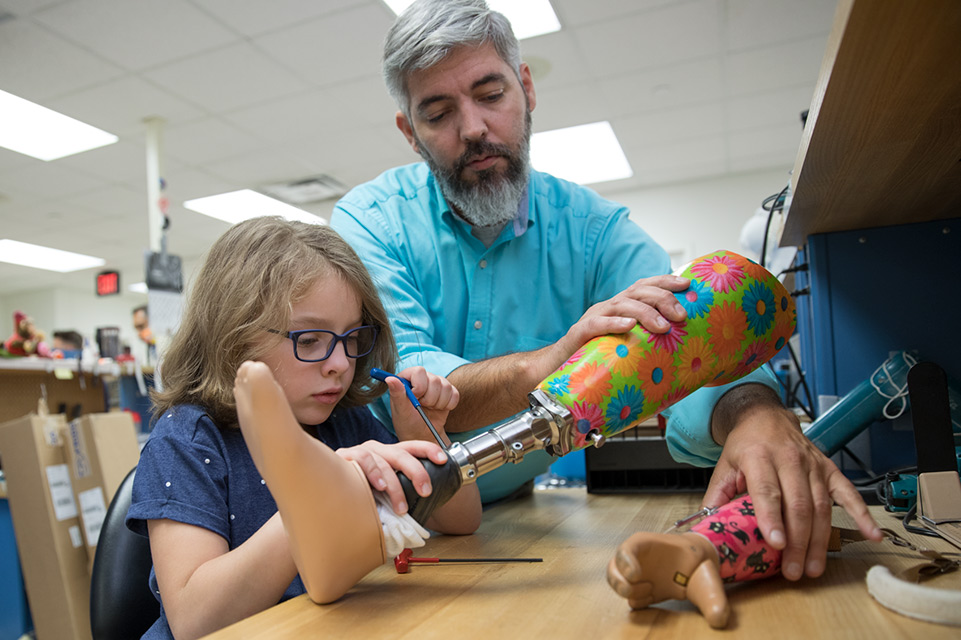Theresa Hennessey:
Well, Shriners Hospitals for Children in Salt Lake City really has a amazing history in pediatric orthopedics.
Kevin Martin:
We are a pediatric orthopedic specialty hospital, serving children from 18 years of age and younger who have orthopedic needs.
Theresa Hennessey:
We have a tradition of taking care of children here and have attracted the most difficult cases.
Kristen Carroll:
It is our honor to take care of children from complex to simple to in-between problems in orthopedics and involve multi-specialty care for them that involves not only expert medical care, but therapy care, [inaudible 00:00:44] seeding care, orthotics, and prosthetics care.
Theresa Hennessey:
Because we have so much experience and because we treat so many patients with really rare conditions, we can offer so many more options and offer families and children hope.
Gail McGuill:
Our patients and families tell us that they have a wonderful experience when they come to Shriners Hospital in Salt Lake City.
Kevin Martin:
We provide multi-specialty clinics where patients can come and see actually several different physicians during one appointment.
Theresa Hennessey:
If you come in and you need a brace, or you need a thesis or you need surgery, I can talk to the family, the nurses talk to the families about what to expect in scheduling surgery. I can call my orthotics guy and say, "Come over here, look at this with me." We go over it together. We figure out what's not working or what we want to do. It's all right here in the same building and we all talk to each other every day. We lunch together. We are truly a team that is focused on the child.
Gail McGuill:
The entire team works really well together to get that optimum care for the child so that they have the best outcome that they can have.
Kristen Carroll:
We have an exceptional wheelchair and seating department here. People come from all over the Intermountain West, and frankly all over the country. Perhaps the most wonderful thing about our seating department is the fact that if somebody outgrows a wheelchair, they bring it back. We refurbish that wheelchair and hopefully give it to the next kid. It really creates a community feel amongst not only our seating department but our seating patients, which is the most important thing.
Theresa Hennessey:
One of the really exciting things we have here is what we call the EOS machine. The EOS machine is kind of like a phone booth, but you stand in and an x-ray is taken. It's an x-ray that gives us more information than any other series of x-rays we can take in one shot. It does it with half the radiation and in some cases up to 90% less radiation and still gives us more information than we could get before. It's on the forefront of technology and what we do in pediatric orthopedics.
Kristen Carroll:
Our prosthetic orthotics department is probably our most fun department here. They are a wonderful group of people who will do anything to make sure that the orthotics fit comfortably on our children, and that the prosthetics are state-of-the-art and exactly what the child needs. I think one thing that we do that's very unique is if we operate on a child's foot, often the prosthetic orthotics department will come into the operating room, mold that child for their new orthotic. Then when that cast comes off four to six weeks later, that orthotic is ready to roll. We don't have an interim step where that kid has to wait two to three weeks to start their therapy. We're able to start it right away.
Our therapy department is very rich here. We have physical therapy, we have occupational therapy and we have speech therapy as well that helps us not only with children with speech issues but also with swallowing issues. Therapists use the recommendations from the gait lab, as well as from the clinic and the operating room to help make sure that every child reaches their full potential.
Bruce MacWilliams:
The Shriners Hospitals for Salt Lake City Movement Analysis Laboratory is one of just currently nine accredited laboratories in the United States.
Kristen Carroll:
Not every Shriners Hospital has a gait lab, and certainly not every hospital. The gait lab gives you a very moment-by-moment analysis of how the child's muscle and skeleton is functioning as they move through space.
Theresa Hennessey:
I think that what gets lost in medicine today is why we're doing it.
Kristen Carroll:
There are certainly systems out there where if things cost too much, they may be disallowed for the patient. That's never the case here.
Kevin Martin:
That's really what we're here for is to make sure that no one gets turned away. We don't ask about finances upfront to determine whether or not they're going to be seen.
Kristen Carroll:
We are doing this because we love kids. All of us are in it because we really believe in the mission of giving a child superb care, regardless of a child's ability to pay.
Stephanie Dahl:
I genuinely believe that's the philosophy of everyone here, is that they love these kids. They want to do the best for them, and they're willing to give it their all, and they do.
Kevin Martin:
Kids who come here view this as a life experience, not a one-time event because when they come here, they become part of our family.
Jon Guss:
You always feel like in this hospital, there's a happy ending.
Stephanie Dahl:
It's all because of Shriners that brought them to this point where they're healthy and happy and beautiful.


















